Annual population growth in Mexico slowed to just 1.2% during the past 10 years as young people increasingly prioritize work over starting a family and consequently have fewer children on average than their parents and grandparents.
Mexico’s population was just over 126 million last year, according to 2020 census results published Monday by the national statistics agency Inegi. The figure represents an increase of 12.2% compared to 2010 when the population was 112.3 million.
The annual growth rate of 1.2% over the 10-year period is the lowest since the start of the 20th century. In the 1950s, ’60s and ’70s, annual population growth was above 3% before falling to 2% in the ’80s, 1.9% in the ’90s and 1.4% in the first decade of the 21st century.
Baruch Sangines, a demographer and geographer, told the newspaper Milenio that Mexico could reach 0% annual population growth in a period of three to four decades if the trend continues. That would place Mexico in a similar situation to European countries in the 1990s, he said.
Sangines said that a major factor behind the decrease in population growth is that more people are focusing on their careers rather than getting married and having kids at a young age.
“Our grandparents, the baby boomer generation, had up to eight or nine kids at a very young age. There was a lower death rate [than in the previous wartime period] and a higher birth rate, which produced a population explosion,” he said.
“[Among] the new generations, especially in large cities, everyone wants to work and a lot [of young people] don’t want to get married. If they do decide to get married, [many couples] only have one child,” Sangines said.
The census found that women now have an average of 2.1 children compared to 2.6 in the year 2000. Unlike some other countries, Mexico depends very heavily on the birth rate for population growth because immigration levels are low.
Sangines said that migration helped to boost the population of European countries after the growth rate declined in the ’90s but noted that Mexico is not the final destination for many migrants.
“They [only] cross [Mexico] to go to the United States,” the demographer said, adding that questions need to be asked about what Mexico will do to boost population growth in the coming decades.
The Inegi census also found that 1.21 million residents of Mexico – about 1% of the total population – were born overseas, almost 800,000 of them in the United States.

In addition, the census found that the average age of Mexicans is 29, an increase of three years compared to the 2010 census and seven years compared to 2000. According to the National Population Council, the average age of Mexicans in 2050 will be 38 and Mexico will no longer have a “demographic bonus” – more working age people than non-working age (children and seniors.)
“Mexico will be an aged country in 2050, … [a lot of] old people with few young people,” Sangines said, acknowledging that the size of the nation’s workforce is on track to decrease as a percentage of the overall population.
“It’s something that worries demographers, the dependency ratio [the number of people not in the workforce depending on those who are] is going to be a lot higher.”
Sangines said the health system and pension system will need to be overhauled in order to meet the needs of a country with a large, older population and relatively few young people.
Some of the other findings of the 2020 census:
- Females account for 51.2% of the population while males account for 48.8%.
- México state, which includes many municipalities in the greater Mexico City metropolitan area, is the country’s most populous state with almost 17 million people. The small Pacific coast state of Colima, with a population of 732,000, is the least populous.
- Quintana Roo recorded the highest annual population growth among Mexico’s 32 states over the past decade. The growth rate in the Caribbean coast state was 3.2%. Querétaro ranked second (2.6% annual growth) followed by Baja California Sur (2.3%), Nuevo León (2.2%) and Aguascalientes (1.9%).
- The illiteracy rate declined to 4.7% from 6.9% in 2010.
- Mexicans have completed 9.7 years of education on average, up from 8.6 years in 2010 and 7.5 years in 2000.
- Among Mexicans aged 12 or older, about three-quarters of males and 49% of females are employed.
- Internet connectivity rose to 52% of households from 21% in 2010.
- Almost 7.4 million Mexicans speak an indigenous language, up from 6.9 million in 2010. However, the percentage of the overall population that speak an indigenous language declined from 6.6% to 6.1%.
- Almost 21 million Mexicans have some kind of disability or physical limitation.
- Some 2.6 million people identify as Afro-Mexican or of African descent.
- Almost three-quarters of the population have some kind of health insurance.
- An average of 3.6 people live in each home.
- About 1.2 million homes don’t have access to running water.
- Nine of 10 homes have a TV, 88% at least have one cell phone, 38% have a computer and 47% have a car.
Source: Milenio (sp), El Universal (sp), Associated Press (en)
